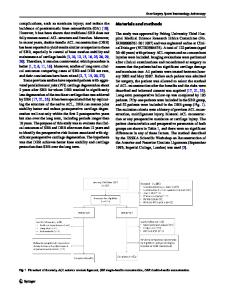Ultrasound-based examination of the medial ligament complex shows gender- and age-related differences in laxity
- PDF / 1,005,270 Bytes
- 8 Pages / 595.276 x 790.866 pts Page_size
- 37 Downloads / 308 Views
KNEE
Ultrasound‑based examination of the medial ligament complex shows gender‑ and age‑related differences in laxity Patricia M. Lutz1 · Matthias J. Feucht1,2 · Judith Wechselberger3 · Michael Rasper3 · Wolf Petersen4 · Klaus Wörtler3 · Andreas B. Imhoff1 · Andrea Achtnich1 Received: 16 July 2020 / Accepted: 14 September 2020 © The Author(s) 2020
Abstract Purpose Ultrasound (US) examination of the medial joint space of the knee has played a subordinate diagnostic role up till now. The purpose of the present study was to describe mean values of medial joint width and to investigate the impact of gender, age, and body mass index (BMI) on medial joint laxity in healthy knees using modern, dynamic US in a standardized fashion in unloaded and standardized loaded conditions. Methods A total of 65 subjects with 79 healthy knees were enrolled in this study. All volunteers underwent clinical examination of the knee. The medial knee joint width was determined using US in a supine position at 0° and 30° of knee flexion in unloaded and standardized loaded (= 15 Dekanewton, daN) conditions using a specific device. Mean values were described and correlations between medial knee joint width and gender, age, and BMI were assessed. Results Thirty-two females and 33 males were enrolled in this study. The mean medial joint width in 0° unloaded was 5.7 ± 1.2 mm and 7.4 ± 1.4 mm loaded. In 30° of knee flexion, the mean medial joint width was 6.1 ± 1.1 mm unloaded and 7.8 ± 1.2 mm loaded. The average change between unloaded and loaded conditions in 0° was 1.7 ± 1.0 mm and in 30° 1.7 ± 0.9 mm. A significant difference between genders was evident for medial joint width in 0° and 30° of flexion in unloaded and loaded conditions (p 18 years with no history of knee injuries and knee pain within the last three months. Exclusion criteria were subjective or objective ligament instability, previous knee operations, subjective knee pain or severe leg malalignment. Subgroup analysis concerning gender, age, and BMI was performed.
13
Knee Surgery, Sports Traumatology, Arthroscopy
Clinical examination All volunteers underwent clinical examination of the knee. Examination of ligament stability included testing the laxity of the MCL and lateral collateral ligament (LCL), as well as the anterior and posterior cruciate ligament. Meniscus was evaluated by joint space tenderness and through the Steinmann test [27]. Frontal plane knee alignment was determined by clinical measures, similar to the Caliper method, as described in 2006 by Hinman et al. [9]. A distance of more than 3 cm (cm) was interpreted as severe leg deformity (medial knee joint line distance or medial malleoli distance). Since only healthy knees were enrolled in this study, using radiographs to determine frontal plane knee alignment would not have been in accordance with ethical standards.
Radiological evaluation US examination was performed by two board-certified radiologists with at least 5 years of experience in musculoskeletal imaging at our institution. All acquired images
Data Loading...











